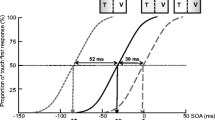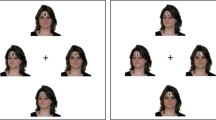Abstract
Lateral and bilateral self-touching movements were studied in a group of men and women performing a series of attentional tasks. In all tasks, subjects were instructed to selectively attend to, and “shadow” (i.e., repeat outloud), one of two passages that were presented simultaneously through earphones. Loudness, voice quality, or thematic content determined which passage had to be selected and shadowed. Performance was significantly better when shadowing on the basis of loudness or voice quality (an earlier, easier selection) than when following content (a more difficult selection that occurs at a later stage in the information processing continuum). However, self-touching rates during performance were not simply a function of task difficulty but seemed to depend on the processing stage at which selection occurred as well as on the type of selection involved. Strong, significant associations emerged between lateral self-touching and performance measures in most of the tasks for the women but in only one task for the men. The sample size on which these correlations are based is small and, hence, these findings must be interpreted with caution. However, in the light of previous findings on sex differences with these tasks, the present results suggest that lateral movements may serve different functions in men and women.
Similar content being viewed by others
References
Barroso, F., Freedman, N., & Grand, S. Self-touching, performance, and attentional processes.Perceptual and Motor Skills 1980,50 1083–1089.
Barroso, F., Freedman, N., Grand, S., & van Meel, J. The evocation of two types of hand movements in information processing.Journal of Experimental Psychology: Human Perception and Performance 1978,4 321–329.
Bush, M., Korchin, S.J., Beall, L., & Kiritz, S. Sex differences in the relationship between trait anxiety and auditory selective attention.Journal of Auditory Research 1974,14 1–20.
Freedman, N. The analysis of movement behavior during the clinical interview. In A. Sigman & B. Pope (Eds.),Studies in dyadic communication. New York: Pergamon Press, 1972.
Freedman, N., & Hoffman, S.P. Kinetic behavior in altered clinical states: Approach to objective analysis of motor behavior during clinical interviews.Perceptual and Motor Skills 1967,24 527–539.
Freedman, N., & Steingart, I. Kinesic internalization and language construction. In D.P. Spence (Ed.),Psychoanalysis and contemporary science. Vol. IV. New York: International Universities Press, 1975. Pp. 335–403.
Freedman, N., O'Hanlon, J., Oltman, P., & Witkin, H. The imprint of psychological differentiation on kinetic behavior in varying communicative contexts.Journal of Abnormal Psychology 1972,79 239–258.
Freedman, N., Barroso, F., Bucci, W., & Grand, S. The bodily manifestations of listening.Psychoanalysis and Contemporary Thought 1978,1 157–194.
Treisman, A.M. Contextual cues in selective listening.Quarterly Journal of Experimental Psychology 1960,12 242–248.
Treisman, A.M. Strategies and models of selective attention.Psychological Review 1969,76 282–299.
Author information
Authors and Affiliations
Additional information
We are grateful to Dr. Norbert Freedman, Director of the Unit at which this work was carried out, for his encouragement and support during all phases of this project, and to Dr. Marshall Bush for generously making available to us his selective listening tasks. Some findings reported in this paper were included in the second author's master's thesis at New York University, Department of Psychology.
Rights and permissions
About this article
Cite this article
Barroso, F., Feld, J.K. Self-touching and attentional processes: The role of task difficulty, selection stage, and sex differences. J Nonverbal Behav 10, 51–64 (1986). https://doi.org/10.1007/BF00987205
Issue Date:
DOI: https://doi.org/10.1007/BF00987205




